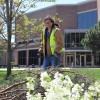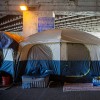

Leave the leaves: Experts say fallen foliage is good for lawns
You don’t have to rake up all those leaves on your lawn this fall. Here’s what environmentalists say to do with them instead.
This coverage is made possible through a partnership between WBEZ and Grist, a nonprofit, independent media organization dedicated to telling stories of climate solutions and a just future.
Every fall trees shed their leaves in a colorful display before becoming the leaf litter that crunches underfoot. This year, leave the leaves alone. Environmentalists say the soil and the wildlife will thank you for it.
Keeping the leaves out of landfills could help check planet warming emissions. Bags of leaves that are trapped in landfills will decompose without oxygen and produce methane, which has 80 times the warming capacity of carbon dioxide. The EPA estimates that solid waste landfills are the third-largest source of human-related methane emissions in the United States.
Illinois banned landscape waste from landfills back in 1990. In Chicago, call 311 for pickup. If you live in a suburb, call the municipality to learn how to discard. Even though Chicago residents can call 311 to compost leaf litter, environmentalists make the case that residents should treat the leaf litter as a resource and use it as Mother Nature intended.
How its supposed to work
Before European settlement, when Illinois was still majority oak savanna, the leaves would fall, blanket the grasses and decompose. The leaves deposited nutrients and organic matter back into the soil. This natural cycle, unencumbered for thousands of years, contributed to establishing some of the most productive soil in the country here in Illinois.
Today leaf litter doesn’t just cycle nutrients between organisms, according to Susan Barton, horticulture professor at the University of Delaware. It provides an inimitable habitat for critters like slugs, snails and earthworms to hide and proliferate.
On its best days, the unassuming layer of leaf litter is the foundation for a complex relationship where wildlife feed and break down the plant matter into smaller bits. On its worst days, it’s blown away with leaf blowers and left to rot in landfills.
Making room for the leaves
But there are other options, such as finely chopping leaves into “free mulch” with a lawn mower or wood chipper. That leaf mulch can then be applied on landscape beds where it can double as a permeable surface, letting water through to the soil and guard against the elements retaining moisture — all the while breaking down and delivering nutrients into dirt.
Another option is composting the leaves as organic fertilizer. In Chicago, gardeners can call 311 to schedule a collection and the city will compost the decaying material.
As a last piece of advice, Barton said if gardeners are struggling to find room in their yards for excess leaves, then they need to make space. Rather than have lawn as the default vegetation from property line to property line, consider flower beds or even vegetable gardens.
Tips to keep in mind
Patti Wetli is an urban nature journalist who told WBEZ’s Reset about the growing movement to encourage people not to throw away bags of leaves.
- Don’t leave piles of leaves on the sidewalk or street where they can become a slippery hazard. Phosphorus, a major pollutant in leaves, can wind up in the sewer system and could get into our water.
- If you don’t want grass and prefer to kill your lawn, leave a carpet of leaves. Otherwise, leave 10 to 15% of leaves and your lawn will survive.
- Pile your leftover leaves in a dead zone on your property and by spring, it will be gone. Even with snow on top, the leaves decompose.
Juanpablo Ramirez-Franco covers climate change and the environment for WBEZ and Grist. Follow him on X at @__juanpab.
More From
Reset with Sasha-Ann Simons


Leave the leaves: Experts say fallen foliage is good for lawns
You don’t have to rake up all those leaves on your lawn this fall. Here’s what environmentalists say to do with them instead.
This coverage is made possible through a partnership between WBEZ and Grist, a nonprofit, independent media organization dedicated to telling stories of climate solutions and a just future.
Every fall trees shed their leaves in a colorful display before becoming the leaf litter that crunches underfoot. This year, leave the leaves alone. Environmentalists say the soil and the wildlife will thank you for it.
Keeping the leaves out of landfills could help check planet warming emissions. Bags of leaves that are trapped in landfills will decompose without oxygen and produce methane, which has 80 times the warming capacity of carbon dioxide. The EPA estimates that solid waste landfills are the third-largest source of human-related methane emissions in the United States.
Illinois banned landscape waste from landfills back in 1990. In Chicago, call 311 for pickup. If you live in a suburb, call the municipality to learn how to discard. Even though Chicago residents can call 311 to compost leaf litter, environmentalists make the case that residents should treat the leaf litter as a resource and use it as Mother Nature intended.
How its supposed to work
Before European settlement, when Illinois was still majority oak savanna, the leaves would fall, blanket the grasses and decompose. The leaves deposited nutrients and organic matter back into the soil. This natural cycle, unencumbered for thousands of years, contributed to establishing some of the most productive soil in the country here in Illinois.
Today leaf litter doesn’t just cycle nutrients between organisms, according to Susan Barton, horticulture professor at the University of Delaware. It provides an inimitable habitat for critters like slugs, snails and earthworms to hide and proliferate.
On its best days, the unassuming layer of leaf litter is the foundation for a complex relationship where wildlife feed and break down the plant matter into smaller bits. On its worst days, it’s blown away with leaf blowers and left to rot in landfills.
Making room for the leaves
But there are other options, such as finely chopping leaves into “free mulch” with a lawn mower or wood chipper. That leaf mulch can then be applied on landscape beds where it can double as a permeable surface, letting water through to the soil and guard against the elements retaining moisture — all the while breaking down and delivering nutrients into dirt.
Another option is composting the leaves as organic fertilizer. In Chicago, gardeners can call 311 to schedule a collection and the city will compost the decaying material.
As a last piece of advice, Barton said if gardeners are struggling to find room in their yards for excess leaves, then they need to make space. Rather than have lawn as the default vegetation from property line to property line, consider flower beds or even vegetable gardens.
Tips to keep in mind
Patti Wetli is an urban nature journalist who told WBEZ’s Reset about the growing movement to encourage people not to throw away bags of leaves.
- Don’t leave piles of leaves on the sidewalk or street where they can become a slippery hazard. Phosphorus, a major pollutant in leaves, can wind up in the sewer system and could get into our water.
- If you don’t want grass and prefer to kill your lawn, leave a carpet of leaves. Otherwise, leave 10 to 15% of leaves and your lawn will survive.
- Pile your leftover leaves in a dead zone on your property and by spring, it will be gone. Even with snow on top, the leaves decompose.
Juanpablo Ramirez-Franco covers climate change and the environment for WBEZ and Grist. Follow him on X at @__juanpab.











